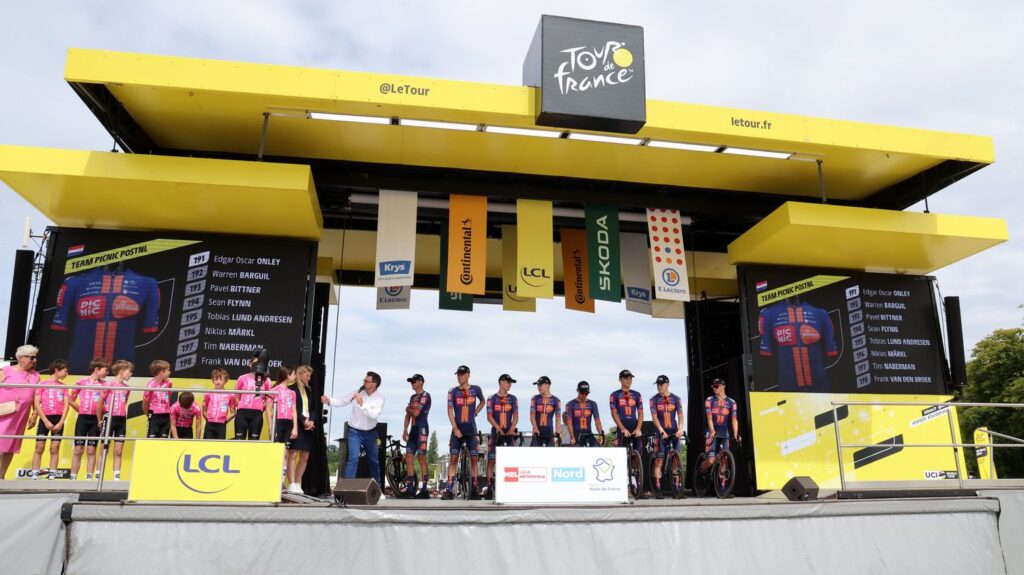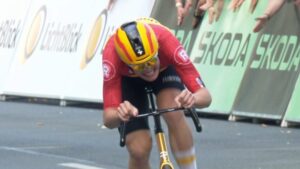
Hundreds of trucks allow, every day, to install the villages departure and arrival on several dozen hectares.
On the big loop, cyclists are not the only ones to ensure the show. Each day, in the stages cities, two huge ballets take place, from the end of afternoon to very late at night: those of the installations of the departure and arrival villages. “Every day, we set up two villages in two cities”sums up Yannick Goasduff, head of departures from Amaury Sport Organization (ASO), the company that manages the Tour de France. A feat made possible by “Hundreds of vehicles, technicians, but also coordination with state services, communities”adds Stéphane Boury, arrival manager: “It's a huge three -week mechanic game.”
When the largest cycling race in the world arrives in your city, a year of upstream work is required, to study the smallest details. This allows the organization to install and uninstall these festive areas, designed for the public, the runners and the media, in a few hours. Thus, in Lille, the departure area was fully dismantled before the return of the runners, a few tens of meters away, on the finish. A show that always surprises passers -by, sometimes many to watch for the installation of the village departure from the previous evening. And which requires anticipation of goldsmith.
Between 100 and 120 trucks of 38 tonnes thus take the road every day towards departure, and as much for the arrival. Their role: to install everything before the arrival of the runners, but also of the 150 vehicles that surround the race, and the 170 others that make up the caravan, without forgetting the dozens of media vehicles. A huge fleet that sails thanks to the precious road book, which includes detailed plans of each step city. Enough to allow this long parade, which would make that of July 14, to find its way, in particular thanks to an obligatory crossing point (PPO, in the jargon).
The Tour de France has its own highway code, symbolized by panels whose color and letters speak to initiates, but not to the general public. Without going into detail, this signpost which appears in the municipalities the day before the passage of the race fluidifies the traffic. Thus, despite the colossal number of vehicles, the traffic jams like the one at the entrance to Lauwin-Plancque, this year, are extremely rare. “We work all year round to see how to get our village in a city as well as possible, while valuing this city for broadcasting and the public“Explains Yannick Goasduff.
/2025/07/10/maxnewsspecialtwo273747-686fba7395d19545493552.jpg)
Private boulevards, supermarket parking lots requisitioned, sprawling barrier … When the large loop arrives, she is queen for her passage. “As soon as we receive the candidates from the municipalities, we will do incognito location, to see what is possible”testifies Sébastien BOURY. An ant work which, for Tour 2025, started in April 2024. “When I explain my job, I am asked what I do outside of July: it's simple, I chain the tracking, then the meetings all around the country”summarizes Sébastien BOURY.
“Each stopped city, I spend four times before departure. In fact, I go around France all year round, because excellence is the minimum required.”
Sébastien BOURY, arrival managerIn Franceinfo: Sport
After a long administrative work between November and March, then a feasibility study period, ASO teams draw the precious cards that will compose the road book. “All the official documents are completed in March, after we adjust on the margins. But at the end of March, we know the place of each truck, each tent in each step city, so that each city can then work on the service plans, traffic restrictions”, explains Yannick Goasduff.
A week before the big departure, the logistics teams of the Tour de France take possession of the host city, for several days of life -size tests. “We deploy the whole fleet, trucks, helicopters”specifies Sébastien BOURY. “”Then we hit the road. Every day, as soon as the runners arrived, I go to the next day line to take stock with the local elected officials. In the morning, we have another point at 6:30 am to coordinate the whole installation, and another at 10 a.m. On the Tour, being on time is already late. “
/2025/07/10/maxnewsspecialtwo277340-686fba73cac3f972201823.jpg)
500 technicians are thus activated every day to unload and place the 120 semi-trailers necessary for arrival, but also barriers, generators, TV production trucks, VIP spaces, podium, canteens, shower trucks … “Each night, three players are in the area to properly position the vehicles”details Sébastien Boury. “This is called the technical zone of arrival, it is a small town in total autonomy. Without forgetting the adjoining press center, which must accommodate 200 journalists every day.”
“You also have to find the car parks for the guests, the 23 team buses, the eight light team vehicles. There are a minimum of one kilometer for the team parking, a hectare for the caravan car park. In total, we need seven hectares on each arrival.”
Sébastien BOURY, arrival managerIn Franceinfo: Sport
On the departure side, the installation of the technical zone and the departure village starts the day before, from 6 p.m. “Our days start as soon as the departure was given: 30 minutes later, we start the disassembly which lasts four hours, then we head towards the departure of the next day”explains Yannick Goasduff, “Just in the departure village, we have 5,000 m2 of infrastructure to go up in the night, until about 2 am. At 7 am, the area is sanctuarized. We leave the place to the public to party, with a half hours of entertainment every morning.”
Between the departure village, the different places of life and work, and the technical zone, it takes 25 football fields to accommodate a departure from the Tour de France. “And we must make sure that the public can circulate in the middle of all this, without disturbing the runners and those who work on the Tour”recalls Yannick Goasduff. “We also have 50,000 square meters of parking in all, every day. With vehicle flow challenges and people to work, so that the champions remain accessible to all.”
/2025/07/10/maxnewsspecialtwo277331-686fba73c78dc919457949.jpg)
This labyrinth thought so that no one gets lost requires at all times. “The most dangerous is the cities where we often step: we must not relax on the pretext that we are used to”explains Sébastien Boury, who also fears each arrival in the mountains: “These are often dead ends, which complicates everything, of course. In particular the evacuation of the teams after the race”.
“This is the back of the medal of this free popular event: we need a place dimensioned at the huge craze around the race.”
Yannick Goasduff, head of departuresIn Franceinfo: Sport
And this without counting on the special stages, such as arrivals at the top, which suppose to have to install two technical zones: one at the top, reduced, and one below, larger. A tour de force which allows for example arrivals at the top of the big passes, but also to go and seek narrow ribs, as in Vire this year. “We went from a logic which, in the past, made us go that where everyone could pass, therefore the caravan, to a new logic today which wants to make the road and the mountain in the Champions“Explains Christian Prudhomme.
“20 years ago we had only one technical zone. In these cases, we could not arrive in Granon, Epernay, Wallers Arenberg, the Beautiful girls board … Now, our obsession is sport”develops the director of the Tour de France, “Thanks to these arrival zones split in two, thanks to technology, we can change the race. We cannot do it everywhere, because it costs more, it is heavy for staff and it mobilizes technical progress that cannot be deployed systematically ”. When a step ends at the top of Galibier, three different technical zones must be deployed on arrival. Child's play for the kings of the logistics of the big loop.


